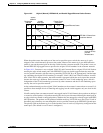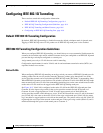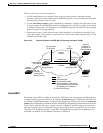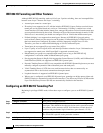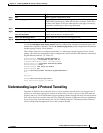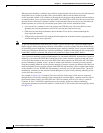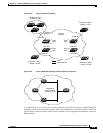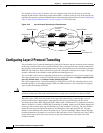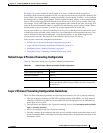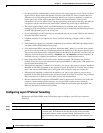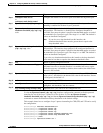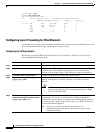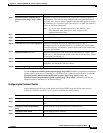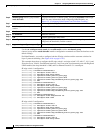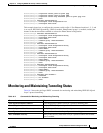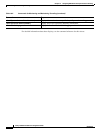
16-11
Catalyst 3560 Switch Software Configuration Guide
OL-8553-06
Chapter 16 Configuring IEEE 802.1Q and Layer 2 Protocol Tunneling
Configuring Layer 2 Protocol Tunneling
See Figure 16-4, with Customer X and Customer Y in access VLANs 30 and 40, respectively.
Asymmetric links connect the customers in Site 1 to edge switches in the service-provider network. The
Layer 2 PDUs (for example, BPDUs) coming into Switch 2 from Customer Y in Site 1 are forwarded to
the infrastructure as double-tagged packets with the well-known MAC address as the destination MAC
address. These double-tagged packets have the metro VLAN tag of 40, as well as an inner VLAN tag
(for example, VLAN 100). When the double-tagged packets enter Switch D, the outer VLAN tag 40 is
removed, the well-known MAC address is replaced with the respective Layer 2 protocol MAC address,
and the packet is sent to Customer Y on Site 2 as a single-tagged frame in VLAN 100.
You can also enable Layer 2 protocol tunneling on access ports on the edge switch connected to access
or trunk ports on the customer switch. In this case, the encapsulation and decapsulation process is the
same as described in the previous paragraph, except that the packets are not double-tagged in the
service-provider network. The single tag is the customer-specific access VLAN tag.
These sections contain this configuration information:
• Default Layer 2 Protocol Tunneling Configuration, page 16-11
• Layer 2 Protocol Tunneling Configuration Guidelines, page 16-11
• Configuring Layer 2 Protocol Tunneling, page 16-12
• Configuring Layer 2 Tunneling for EtherChannels, page 16-14
Default Layer 2 Protocol Tunneling Configuration
Table 16-1 shows the default Layer 2 protocol tunneling configuration.
Layer 2 Protocol Tunneling Configuration Guidelines
These are some configuration guidelines and operating characteristics of Layer 2 protocol tunneling:
• The switch supports tunneling of CDP, STP, including multiple STP (MSTP), and VTP. Protocol
tunneling is disabled by default but can be enabled for the individual protocols on IEEE 802.1Q
tunnel ports or access ports.
• The switch does not support Layer 2 protocol tunneling on ports with switchport mode dynamic
auto or dynamic desirable.
• DTP is not compatible with layer 2 protocol tunneling.
• The edge switches on the outbound side of the service-provider network restore the proper Layer 2
protocol and MAC address information and forward the packets to all tunnel and access ports in the
same metro VLAN.
Ta ble 16-1 Default Layer 2 Ethernet Interface VLAN Configuration
Feature Default Setting
Layer 2 protocol tunneling Disabled.
Shutdown threshold None set.
Drop threshold None set.
CoS value If a CoS value is configured on the interface for data packets, that
value is the default used for Layer 2 PDUs. If none is configured,
the default is 5.



